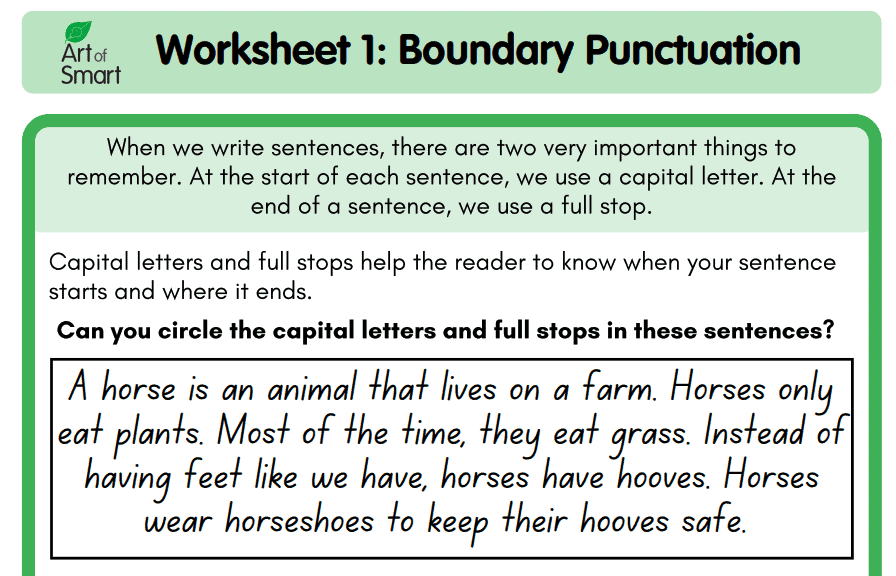So your child has a basic understanding of full stops and capital letters, but are now moving onto other punctuation skills? We’ve come up with a bunch of punctuation worksheets and activities for Year 1 students to develop their understanding of question marks, exclamation marks and capital letters for names!
Completing these worksheets will be a fun way to understand the use of each type of punctuation in a variety of contexts.
Keen to develop your child’s literacy skills? Scroll down for our punctuation worksheets!
Sample of Our Year 1 Punctuation Worksheets
English Skills
Download Our Year 1 Punctuation Worksheets
Searching for punctuation worksheets for different year groups?
If you have a child in another year group, don’t stress! We’ve also got sheets just for them that you can download for FREE — have a look:
Kindergarten | Year 2 | Year 3 | Year 4 | Year 5 | Year 6
Sample of Our Year 1 Punctuation Worksheets
Before you download our worksheets, you can check out a preview of one below:
For the complete set of worksheets and activities on questions marks, exclamation marks and capital letters for names, download our resource below!
English Skills
As your child enters Year 1, they’ll have a foundational understanding of punctuation through the use of full stops and capital letters.
They’ll now continue to develop their vocabulary and reading skills, while familiarising themselves with newer punctuation concepts.
Vocabulary
In order to communicate effectively in a verbal or written manner, building vocabulary is essential!
Constructing basic sentences requires students to develop their vocabulary, and know how to use words in different situations.
A fantastic way to assist in developing your child’s vocabulary is by studying words from spelling lists, and using those words regularly in their daily interactions.
Check out our FREE spelling worksheets for Year 1 students here!
Reading
In Year 1, your child will start to read more autonomously, but will still need guidance as they read through texts.
It’s a good idea to get your child to read aloud so you can indicate parts where they need to pause for certain types of punctuation or alter their tone when reading a sentence with a question mark or exclamation mark.
Looking for resources? Check out our FREE, Downloadable Year 1 Reading Comprehension Worksheets for you to print out at home!
Plus, discover various texts for your child to read with our Year 1 Recommended Reading List here!
Punctuation Use Through Question Marks, Exclamation Marks and Capital Letters
Since your child is in Year 1, they’ll already know the basic functions of full stop and capital letters when making sentences.
Other types of punctuation they will explore are question marks and exclamation marks, which we’ve created worksheets for below!
Questions are a way of expressing curiosity and exclamation marks can be used to express excitement or being surprised.
Download Our Year 1 Punctuation Worksheets
We’ve come up with 5 punctuation worksheets to help your child develop their literacy skills, which you can download for FREE below!
You can also check out our guide to Year 1 English right here!
Looking for some extra help for your child with English?
We have an incredible team of English tutors and mentors!
We offer tutoring and mentoring for students in Years K-12 in a variety of subjects, with personalised lessons conducted one-on-one in your home, online or at one of our state of the art campuses in Hornsby or the Hills!
We’ve supported over 8,000 students over the last 11 years, and on average our students score mark improvements of over 20%!
To find out more and get started with an inspirational English tutor and mentor, get in touch today or give us a ring on 1300 267 888!
Jessica Loch is a K-6 English Resource Designer at Art of Smart in her second year at the University of Sydney studying Primary Education. She is passionate about learning and helping young students to grow and improve.





